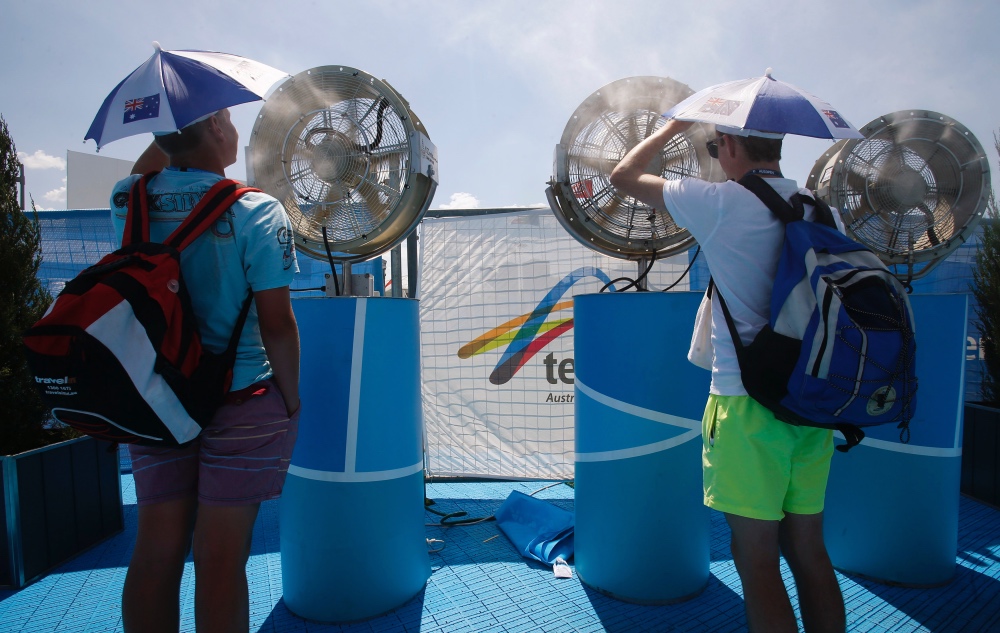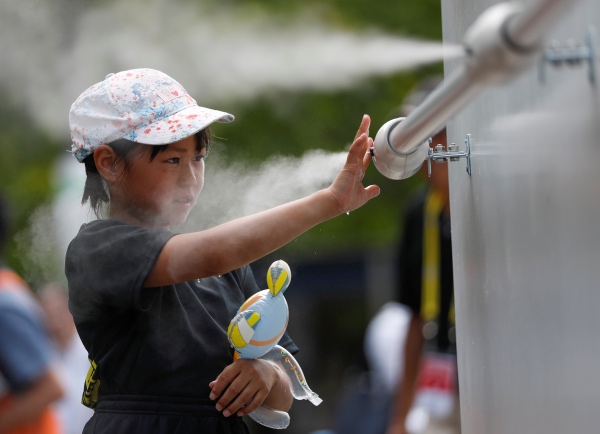
LIN TAYLOR, of Thomson Reuters Foundation, reports…
London
Thomson Reuters Foundation
As a professional ultrarunner, who competes at distances longer than a marathon, Clare Gallagher has tackled plenty of challenges, from mountains to heat.
But none have been as much of a threat to her career as the US West’s worsening forest fires which, fuelled in part by stronger droughts linked to climate change, have led to choking air across big swathes of the region each summer.
Fires and poor air quality cancelled two major races, last November and in February, said the 27-year-old, who lives in Colorado.
“Megafires are becoming more common. Races are getting cancelled at a much higher rate than in the past,” Gallagher told the Thomson Reuters Foundation.
“As a professional runner, it’s crazy. Those were the only two races I had on my calendar in those winter months and it basically knocked my racing schedule to zero,” she said.

Spectators cool off in front of misting fans at the Australian Open 2014 tennis tournament in Melbourne on 16th January, 2014. PICTURE: Reuters/Bobby Yip
As the planet heats up, competing in – or even watching – many outdoor sports is becoming increasingly challenging as climate change brings harsher heatwaves, more intense rain, greater fire risks and other threats.
As heatwaves hospitalise players in sports from tennis to cricket, competitions are cancelled due to extreme weather, and winter sports try to cope with less snow and ice, sporting bodies have begun eyeing ways to adapt to the changing climate.

A visitor experiences a large-scale misting tower dispensing ultra-fine mist during a proving test of heat countermeasures for the Tokyo 2020 Olympic and Paralympic Games at the venue of FIVB Beach Volleyball World Tour, also acting as a test event for the games, in Tokyo, Japan, on 25th July. PICTURE: Reuters/Issei Kato.
ORGANISERS TEST COUNTERMEASURES IN SWELTERING TOKYO AHEAD OF 2020 OLYMPICS
Tokyo
Reuters
With temperatures rising to 35 degrees Celsius and humidity of 75 per cent last Thursday, Tokyo 2020 organisers had the perfect weather to try out their heat countermeasures and preparedness for next year’s Olympics at the beach volleyball test event.
Although it has been less hot this year, a record heatwave in July, 2018, killed more than a dozen people in Tokyo with monthly average temperatures transcending 30 degrees for the first time in 20 years.
Tokyo 2020 organisers will employ wet bulb globe temperature measuring devices at all venues as a step in their readiness for high temperatures.
The WBGT device factors in temperature, humidity, wind speed and solar radiation, producing a rating based on the variables and the Tokyo Metropolitan Government advise citizens against exercising when the WBGT rating is over 31.
On Thursday, however, the WBGT rating at the beach volleyball venue in central Tokyo was as high as 31.7 but organisers said it did not mean that an Olympics event would be cancelled should this happen during the Games.
The WBGT reading will be one of many factors to be considered, in consultation with the sport’s federation, while judging the safety of an event going ahead, the organisers said.
“It all depends on a situation, but for the spectators, we will prepare cooling facilities and goods for them,” said Ken Wakabayashi, an environment official at TMG.
“At the same time, we would like to encourage them to get information on heat countermeasure and enjoy the event.”
Among other countermeasures tested were water vapour sprays for supporters arriving at the venue, shaded or air-conditioned rest areas within the venue, and the distribution of water and ice packs to athletes and fans.
With two people this week needing medical treatment at the beach volleyball, including a person who suffered a heatstroke, organisers also wanted to test their readiness for people falling ill during the Games.
The TMG said their first aid response worked well.
“As far as our First Aid Station is concerned, I think we managed to make a correct judgment and provide an appropriate treatment,” said Tomoko Suemura, who works within TMG’s Games preparation department.
“We feel it is necessary to discuss how to deal with various medical cases in coming months.”
– JACK TARRANT and YOKO KONO
The World Meteorological Organization said in June that 2019 was on track to be among the world’s hottest years on record – another record year in a string of them over the last five years.
That is worrying officials planning events from the 2020 Summer Olympics in Japan to the 2022 soccer World Cup in Qatar.
A scorching heatwave in Japan last summer prompted Tokyo’s Olympics organisers to plan an earlier start time for the event’s marathon race and to cover the course with a reflective layer to try to cut pavement temperatures by up to eight degrees Celsius.
Organisers were also looking at ways to keep spectators cool with tents, fans and sprays of cooling mist.
Qatar, in turn, is aiming to hold the next soccer World Cup – normally a summer event – during the winter, in November and December, to avoid the worst of the region’s steamy heat. It will also install cooling technology in stadiums.
“The sporting body needs to provide those provisions so [fans] don’t get ill or hospitalised,” said Kate Sambook, a climate researcher at Britain’s University of Leeds.
But the Olympics and soccer aren’t the only sports struggling with heat.
Last January, during a match in Australia when temperatures hit 42 degrees Celsius, England’s cricket captain Joe Root was sent to hospital with exhaustion and dehydration.
At the US Open last August in New York, meanwhile, a tennis fan collapsed in the stands and several players requested medical attention during their matches as temperatures soared above 32 degrees Celsius amid crushing humidity.
As a result, the United States Tennis Association imposed special rules to allow players a 10-minute break between the second and third sets under such conditions.
The World Health Organization has said heat stress linked to climate change is likely to cause 38,000 extra deaths a year worldwide between 2030 and 2050, as it worsens existing health problems and provokes heat stroke and exhaustion.
In Britain, golf, cricket and soccer are also suffering from wetter weather linked to climate change, according to a 2018 study by the Climate Coalition, a British campaign group.
More downpours meant pitches and fairways were more likely to be soggy or unplayable, the study said.
“There’s definitely a trend that we’re seeing where sport is being affected by climate change” – something that has “significant financial repercussions,” said Sambook, who co-authored the report.
The England and Wales Cricket Board said 27 per cent of England’s home One Day International games since 2000 had been played with reduced overs due to rain disruptions, the study noted.
When heavy storms hit the country in 2015-16, the cricket board spent about a million pounds in 2016, and £1.6 million to fix facilities and to support affected clubs, the report said.
Extreme weather also caused the cancellation of 25 Football League fixtures during the 2015-16 season, it said.
Major national football leagues offered about 750,000 pounds to help flood-affected clubs that season, while the Football Association, Britain’s soccer body, spent 48 million pounds to weather-proof pitches across the country, the report added.
Niclas Svenningsen, who heads the Climate Neutral Now initiative under the UN climate secretariat, said sport’s global appeal could be a way to drive more urgency for action on climate change.
“Sports…has a very big potential to be part of the solution” both by cutting its own emissions and creating demand to deal with climate threats, Svenningsen said.
The secretariat launched an initiative last December to get sporting groups to reduce their climate impact. Nearly 50 bodies have signed up so far, it said, including tennis, soccer, ice hockey, sailing and the Olympics.

Runners in a stadium. PICTURE: Steven Lelham/Unsplash.
Svenningsen hopes the signatories will host climate neutral sporting events by having matches close to public transport, reducing plastic waste and using renewable energy at their facilities.
“The reach of sport is tremendous. There are more people watching sports games than listening to politics. We don’t want to preach to the converted,” he told the Thomson Reuters Foundation in a phone interview.
The International Olympic Committee said climate change is now an underlying factor in terms of host city selection and how the games will run in the future.
“We are starting to live in the consequences of climate change. Summers are getting hotter, winters are getting shorter. Snow is being found at higher locations,” said Michelle Lemaitre, the IOC’s head of sustainability.
“It is going to be a problem in the future, and we need to start addressing it now,” she said in an interview.
By 2050, less than half of the 21 cities that have hosted the Winter Olympics will be cold enough to host the games again, according to a 2018 study by Canada’s University of Waterloo.
And in the 2080s, that number will whittle down to just four cities – Calgary in Canada, China’s Beijing, Albertville in France and Salt Lake City in the United States – if global warming is not curbed and temperatures rise 4.4 degrees Celsius above pre-industrial levels, the study said.
That is well above the international goal, agreed in 2015, of holding average global temperature rise to “well below” two degrees Celsius, and ideally 1.5 degrees Celsius above pre-industrial levels.
“You can essentially kiss winter sports goodbye in the not-too-distant future. You can basically only have winter sports in high-altitude alpine regions for a very limited period of time in the year,” Svenningsen said.





